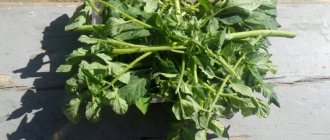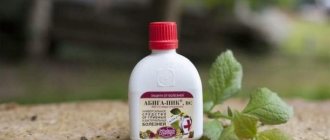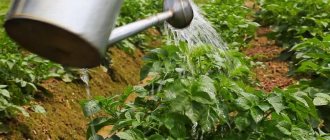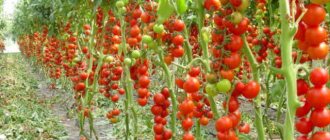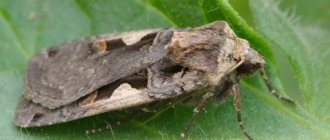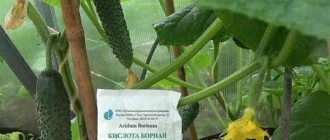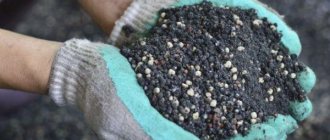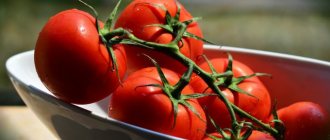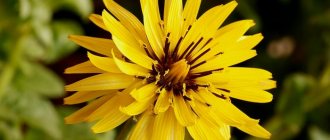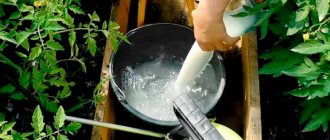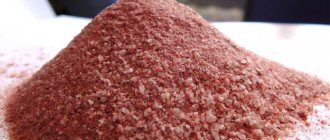The value of green tops of vegetable crops as fertilizer
Tomato tops as fertilizer are plant organic matter. During growth, tomatoes consume a large amount of nitrogen, which accumulates in the leaves, as well as a huge amount of microelements, including calcium. All this greenery, which is simply thrown away or burned, can become food for soil microorganisms if it is correctly added to the soil.
Bacteria - lactic acid, nitrogen-fixing and many other varieties, also need food. They mainly use plant residues - roots, dry leaves, branches.
Due to the fact that colonies of microorganisms live in the soil, the top fertile layer is rich in humus. This substance consists of humic acids, which can only be obtained when vegetation passes through the digestive tract of bacteria, earthworms, and insects.
The presence of humic acids is also important for humans, since the immunity of the fruit is transferred to him. By eating vegetables and fruits grown in fertile soil, the body receives more vitamins and minerals than when using only mineral mixtures. "Mineralized" apples or potatoes may look better, but the nutritional value will suffer.
If you consider how much greenery is simply thrown away in the fall, you can judge how many nutrients that were retained by plant tissue are no longer useful. Of course, there are also disadvantages that must be taken into account.
Feeding ornamental plants
Tomato tops are an excellent means for spring feeding of indoor flowers. To do this, it is prepared in advance in dry or liquid form. It is better to choose a cool and dark place to store fertilizer. At the beginning of spring, houseplants begin to grow actively, needing a sufficient amount of nitrogen. A few weeks later, when the first buds appear on the young stems, a little ash should be added to the tops solution to saturate the bushes with potassium.
It is very important to add some synthetic phosphates to the pots along with organic fertilizers. Thanks to them, the plants will bloom much longer.
Infusion from tomato tops can also be used to treat decorative flowerpots affected by aphids. It is very important to spray the entire plant at once, since insects usually like to lay their eggs on the inside of the leaves.
Advantages and disadvantages
The disadvantages of this feeding are that many plants get sick during growth and fruiting. Fungal diseases are especially dangerous, which can affect the entire plantation of tomatoes, potatoes or cucumbers in a week. If the owner of the site carefully monitors the greenery, sprays or burns diseased plants in a timely manner, then there is nothing to fear.
But if you do not take the fungus seriously, you can end up with contaminated fertilizer, after which you will have to destroy all crops and fruits. The fact is that with low immunity, the fungus can cause a lot of trouble to humans, so it’s better not to risk your health.
The advantage of plant organic matter is that it can be used in many ways, including safe ones, such as making compost. It takes longer, but during composting, all pathogenic microorganisms die and fertilizer from tomato tops becomes absolutely safe.
Liquid fertilizing is done quickly and can eliminate nutrient deficiencies in a short time. At the same time, almost all the microelements that the plant has accumulated for its needs pass into the water.
The cost of such fertilizer is the lowest of all known. It only takes time to properly put the raw materials into a compost heap for rotting or prepare a liquid fertilizer.
What tops are used
Tomato leaves and stems are used for adding to compost heaps, preparing infusions, decoctions, and for mulching. Side shoots removed during planting, cut tomato leaves, as well as bushes collected from the beds after harvesting are suitable.
Early low-growing varieties and hybrids finish bearing fruit by the beginning of August, late-ripening indets in greenhouses bear fruit until the first cold weather. Therefore, bushes are removed from the beds at different times, taking into account the varietal characteristics of tomatoes and the end of fruiting.
In any case, use only healthy tops, without damage, traces of late blight, or powdery mildew. Leaves and stems are only green; all wilted and yellow shoots are removed. Do not take tops with mold, rot, black or brown spots. Such plants are destroyed.
Green stepsons and leaves are used for infusions or compost immediately after breaking off; tomato bushes torn from the ridges in the fall are preferably dried in the sun before being placed in compost.
On a note! Tops for infusions are prepared for future use by drying them and then using them as needed.
Methods for preparing tomato tops
There are several ways to use green residues from tomato bushes, beets, carrots, and potatoes:
- green fertilizer liquid;
- composting;
- brewing;
- infusion;
- preparation of ash.
Ash is a safe fertilizer, but it is necessary to burn greens in a closed container, for example, an old barrel, so that fungal spores from the soil and grass do not get there. Ash varies in composition depending on what is burned.
In this case, the fertilizer will contain a lot of potassium, less calcium and other trace elements. Nitrogen, unfortunately, evaporates into the atmosphere when plant residues are burned - this is the disadvantage of ash fertilizers. But the ashes can be stored longer and used at any time.
Green tea
To prepare green fertilizer, you need to put clean greens in a barrel and add water to infuse. Usually they take a third of the container of greens, the rest is water. Insist until the fermentation process begins with the release of gases.
This means the infusion is ready. For young seedlings, the concentrate is diluted 1:2 and watered at the root. For mature plants, you can use an undiluted stock solution. It is advisable to moisten the soil before watering.
Mineral mixtures containing phosphorus and potassium are added to the tincture if watering is done before flowering. During this period, nitrogen alone is no longer enough and the crops may lose their ovaries.
This fertilizer is used immediately, because it is useless to store it - the nitrogen will escape into the atmosphere, and the solution will begin to emit unpleasant odors.
Decoction
To be sure that there are no fungal spores, garden tops are scalded with boiling water. To do this, brew in an iron barrel:
- Fill it one third with waste.
- Boil enough water to completely cover the tops.
- After the hot liquid has cooled, the rest of the volume is added with cold water.
Then use it as in the previous recipe. For young plants, half a liter of decoction is enough, for adults – a liter at the root.
It is better to do foliar spraying with a decoction, because this way there is less risk of infecting healthy plants with fungus.
As a fertilizer
The herbal infusion is prepared much faster than humus, and in terms of the content of useful microelements it is not inferior to it. Any mowed vegetation from the site is suitable for preparing this fertilizer, and the added tops make the solution more nutritious. But to prevent such fertilizer from turning into poison, the content of tomato leaves and stems should not exceed a quarter of the total herbal mass.
The container in which the infusion is prepared is filled three-quarters of the volume with the green mixture. Pour water up to the edges of the barrel, mix and cover with a lid or wrap with film. Allow the solution to brew for at least 7 days.
The mixture has a specific putrid smell, so it is better to keep the barrel with the infusion away from the house and recreation area. A liter of the finished concentrate is stirred in a bucket of water and watered directly to the roots of garden plants.
How to make compost from tops
Composting is a method of preserving nutrients that involves aerobic microorganisms. First you need to build a composter with your own hands or buy a ready-made one. In large areas, two or even three-section compost heaps are made, since the amount of waste cannot fit into one.
The fact is that the pile must have strict proportions: 1 meter wide, 1.5 m high. Length doesn't matter. This is done because air must penetrate evenly inside, otherwise microorganisms will die without oxygen, and the raw materials will begin to rot.
In order for the combustion process to begin in compost, it is necessary to maintain the proportions of the components. Nitrogen-containing substances, which include tops, should be 4 times less than carbon-containing substances. Therefore, for every 10 cm of greenery or manure there should be 40 cm of straw, hay, peat, humus, dry leaves or toilet paper.
On average, without human intervention, a compost heap matures in about 1 – 1.5 years. To speed up the process, summer residents shovel the pile once a week so that more oxygen gets inside. In this case, bacteria multiply faster and process organic matter. When laying, you can spill each layer with a biological solution and speed up the proliferation of microorganisms.
When composting, fungal spores die from exposure to high temperature: in properly formed compost it rises to 70 degrees.
If contaminated tops are included in the compost, it must be kept for at least 3 years before being used in the garden. During this time, the infection dies.
Additive to compost
Cut branches and leaves of tomatoes can be poured into a compost pit to obtain humus. The shoots are laid in layers, alternating with soil, and compacted. To stimulate the decomposition process, the mixture is watered with a solution of manure or urea.
The compost pit is dug in the shade, as the sun's rays slow down the rotting process. It is covered with perforated film or tarpaulin on top to further block out the light. Under these conditions, the compost is ready for use within a year.
But if the tops are infected with late blight or bacteria, then the optimal time for them to rot will be at least three years. During this period, dangerous microorganisms will die, and the mass will be processed into crumbly and nutritious humus. When applied to the soil, it will improve its structure and enrich the fertile layer with nutrients.
Use against pests
If vegetable crops are attacked by pests, you can make a weekly tincture of tomato tops and spray the plants. The leaves contain essential oil, which has an unpleasant taste, so the insects leave.
For aphids, the infusion of tomato leaves is poison - the pests do not go away, but die if they are sprayed. This is explained by the presence of solanine in the tissues, a toxic substance that is present in the tops of all plants of the nightshade group.
For 10 liters of water you need to take 4 kg of fresh tops or 1 kg of dry ones, leave for 4 hours, then simmer over low heat for half an hour, let cool. Before spraying, the broth is filtered and diluted in the following proportion: 1 liter of broth per 4 liters of water.
The effectiveness of natural remedies is lower compared to chemicals, so they are used for prevention. If pests have already colonized the area, you will have to use garden chemicals.
Benefits of tomato leaves. 2 Useful properties
Tomatoes have many beneficial properties:
- They have an anti-inflammatory, antibacterial effect on the body. Helps fight stress. Promote tissue rejuvenation.
- Tomatoes are a source of fiber. Their use improves the functioning of the gastrointestinal tract.
- Eating vegetables helps you lose weight. 100 grams of tomatoes contain only 18 calories.
- Tomatoes are good for pregnancy. They contain large amounts of folic acid.
- Tomatoes are recommended for consumption by people with diabetes. They do not contain cholesterol and harmful fats, and the sugar content is minimal.
- Tomatoes can help fight colds and viral diseases. One ripe vegetable contains half of a person's daily requirement of vitamin C.
- The vegetable helps fight blood diseases, including anemia. Tomatoes contain iron, and substances contained in tomato seeds can reduce blood viscosity and prevent the formation of blood clots. A few glasses of tomato juice a day will help normalize blood composition.
- Eating vegetables helps increase immunity, cleanses the liver and lungs of harmful substances, and removes waste and toxins.
- The presence of tomatoes in the diet has a beneficial effect on the functioning of the genital organs in men and prevents the development of prostate cancer.
- Women can use this vegetable not only as food, but also for cosmetic purposes. Using tomatoes, you can prepare rejuvenating homemade masks for the face and body.
- It is recommended to apply the vegetable pulp to the skin when receiving minor burns, wounds, scratches, or small ulcers.
- Tomatoes help normalize venous circulation in the legs of people suffering from varicose veins. To do this, it is recommended to regularly smear the sore limbs with tomato puree.
Which is better - watering or spraying with green tincture
For spraying, you can use a simple tincture. It is advisable when there is no rain, otherwise it will wash away the nutrients. In order for the liquid to stick better to the leaves, grated laundry soap is added to it.
Watering is a complete feeding, especially if you add herbal starter to the liquid according to the following recipe:
- Chop fresh grass and tops and pour into a barrel.
- Add the same amount of water.
- Add double superphosphate - 50 g per bucket of water. This is necessary so that the plants absorb potassium well.
- Leave to ferment for 10 days. Make sure that the infusion does not “run away” - stir periodically. When the foam stops appearing when stirring, the herbal starter is ready.
Tomato leaves as fertilizer in the starter are diluted 1:2 or 1:4 if the plant is mature or young. Before flowering, potassium sulfate is added to the starter. Make sure that there is no sediment left at the bottom, because superphosphate does not dissolve well. An average of 3 to 5 liters of liquid starter is used per square meter of area. It simultaneously nourishes and protects garden crops from diseases.
For ornamental crops
Tomato tops as fertilizer can be stored both in dry and liquid form, but only in a cold place. It is used for ornamental plants in the spring, when they wake up and need nitrogen fertilizing. Ash solutions are more appropriate during the period of bud setting, since at this moment potassium is most intensively consumed.
Phosphates must be added along with green fertilizers, otherwise, with an excess of potassium, the flowers will have all the signs of potassium starvation - the plants will bloom poorly.
Video: Tomato tops from pests and as fertilizer
Ornamental crops affected by aphids can also be wiped or sprayed with infusion. It is necessary to treat both sides of the leaf at the same time, since insects lay eggs on the inside.
Preparation of mulch
Another option for using the tops remaining after the formation of tomato bushes is to lay them between rows as excellent mulch. The component is suitable for processing most garden crops, as well as fruit trees and shrubs. The main advantage of tomato mulch is its ability to retain water in the soil, due to which the number of necessary waterings is significantly reduced. With the help of mulching, gardeners protect their plots from excessive growth of weeds and constant weeding of the area.
A few months after planting, the tops will completely rot, saturating the soil with useful microelements. By the way, a similar process around trees protects tree trunks from pests that settle in the soil for the winter.
Where to put carrot tops. Where to put carrot tops
Carrot tops contain many useful substances, so they are used in RјРµРґРёС†РеРЅРµ. Although it is usually not prepared for consumption. The fruit itself also contains vitamins, but we will not talk about this, since everyone knows this very well.
In fact, carrot tops have a spicy aroma, so they can even be added to soups or salads. And some people put the plant in pies and casseroles. To make a decoction or tincture from it, you need to prepare raw materials. To do this, tops are taken in June or July. At this time, the stems are saturated with useful microelements. Then the plant is washed from the soil and dried with a towel. Only then can the tops be chopped and placed in the shade. When the workpiece is completely dry, you can place it in jars with tight lids. This herb will last for about a year, retaining all its healing properties.
You can make tea from the resulting spice, which will help with colds. Or add it to a dish to give it an unusual taste. But we recommend preparing medicines based on dried carrot tops for various diseases. However, it is not recommended to use such tinctures if you have a stomach ulcer or intestinal problems. This will only worsen the condition. Consult your physician before use.
Healing remedies from carrot tops
For diseases of the genitourinary system, a decoction should be made. A handful of dried herbs is added to half a liter of boiling water. The mixture is infused for an hour, and then taken 3-4 times an hour before meals.
How tea should be brewed and consumed for hemorrhoids, insomnia, and poor eyesight. If you have skin inflammation or joint disease, you can apply lotions. Brew the tincture and soak cotton wool or gauze in it.
Some information about the tops
The large tomato family includes hundreds of varieties and hybrids, and when caring for them, it is necessary to take into account their growth characteristics, fruit formation and other characteristics. So, many tomatoes are formed into a bush by removing the stepsons and leaving 1-3 trunks to achieve a better result.
The leaves and shoots remaining after pruning are thrown away or, at best, put in compost. Meanwhile, these “mountains” of greenery are useful for preparing fertilizers and useful compounds for pest control. They can be used both on tomato beds and for other vegetables, berry bushes or fruit trees.
The most dangerous pests on cucumbers
Tomato leaves contain potassium, organic acids, a number of vitamins (groups C, PP, B), nitrogen, and essential oils. In addition, the composition includes solanine, an alkaloid with insecticidal and fungicidal effects. Due to this component, the tops are used as a basis for infusions and decoctions against insect pests.
What tops to use
Pruning tomatoes involves removing stepsons, leaves of the lower tier, pinching the main and additional stems. Along with green and healthy but superfluous shoots, yellow and dried leaves and shoots damaged by pests or diseases are removed. Only healthy tomato greens are suitable for further use - without traces of late blight, yellowness, areas affected by aphids or other pests.
Early tomatoes yield their harvest by the beginning of August, so all healthy bushes are removed and used for composting. It is recommended to burn damaged tops.
